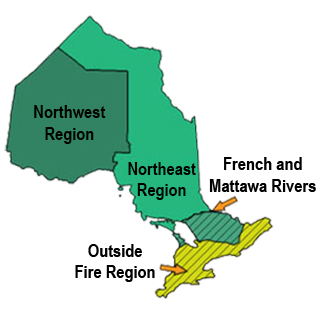Forest fires
Information about the current forest fire danger, forest fire activity and fire restrictions across the province.
Report a fire
 To report a forest fire call
To report a forest fire call
 South of the French and Mattawa rivers please call 911.
South of the French and Mattawa rivers please call 911.
Interactive fire map
Real time updates.
Our interactive map visually shows active fires, current fire danger across the province and restricted fire zones in effect.
The map now shows perimeters for some fires over 40 hectares in size. Please note that not all fires are mapped and perimeters are not updated every day (may differ from the size reported in the table).
We recommend using Google chrome as your web browser to access the map.
Forest fire updates
Ontario's wildland fire season extends from April 1 to October 31. Provincial outdoor burning regulations are no longer in effect. Please use caution with outdoor fires. Residents within municipal boundaries should check with their local fire department for burning restrictions or permitting requirements. November 1 marked the beginning of FireRanger recruitment for the 2026 fire season. Interested candidates can submit their application at ontario.ca/FireRanger.
Restricted fire zones
There are currently no restrictions in effect.
Contact information
Northeast Region
Evan Lizotte
Fire Information Officer
Alison Lake
Fire Information Officer
Isabelle Chenard
Fire Information Officer
Northwest Region
Alison Bezubiak
Fire Information Officer
Chris Marchand
Fire Information Officer
Social media
Check out our Facebook, Instagram and X (formerly Twitter) accounts for safety tips and other forest fire related information.
For highway conditions, including road closures:
For air quality in your area, please visit:
public weather alerts for Canada
For smoke drift conditions across North America, visit:
smoke drift across North America
For information about forest fire smoke and your health, consult:
smoke and your health
Fires: year to date
The figures below represent the year-to-date total number of forest fires inside Ontario’s fire region for the 2025 fire season, as they compare to the 2024 season and to the 10-year average.
- 643fires in 2025
- 480fires in 2024
- 71210-year average
Fire bans in provincial parks
For all park fire bans see:
Ontario parks alerts
You are responsible for fires you light
From April through October, people using outdoor fires must follow strict guidelines under the Forest Fires Prevention Act of Ontario to ensure their fires are properly managed.
Anyone who starts a fire outdoors must take all necessary steps to tend the fire, keep it under control, and make sure the fire is out before leaving the site. A person failing to burn safely could be fined and held responsible for the cost of putting out the fire. People living in municipalities should check with local fire officials for bylaws on outdoor fires.
Hunters
- check the interactive fire map to find out where the active wildland fires are in Ontario.
- be aware of FireRangers who may be working in forested areas.
- check your surroundings for FireRanger activity before discharging your firearm to help keep everyone safe.
About Aviation, Forest Fire and Emergency Services (AFFES)
Visit our forest, wildland and outdoor fires page for more information on AFFES and wildland fire management, including:
